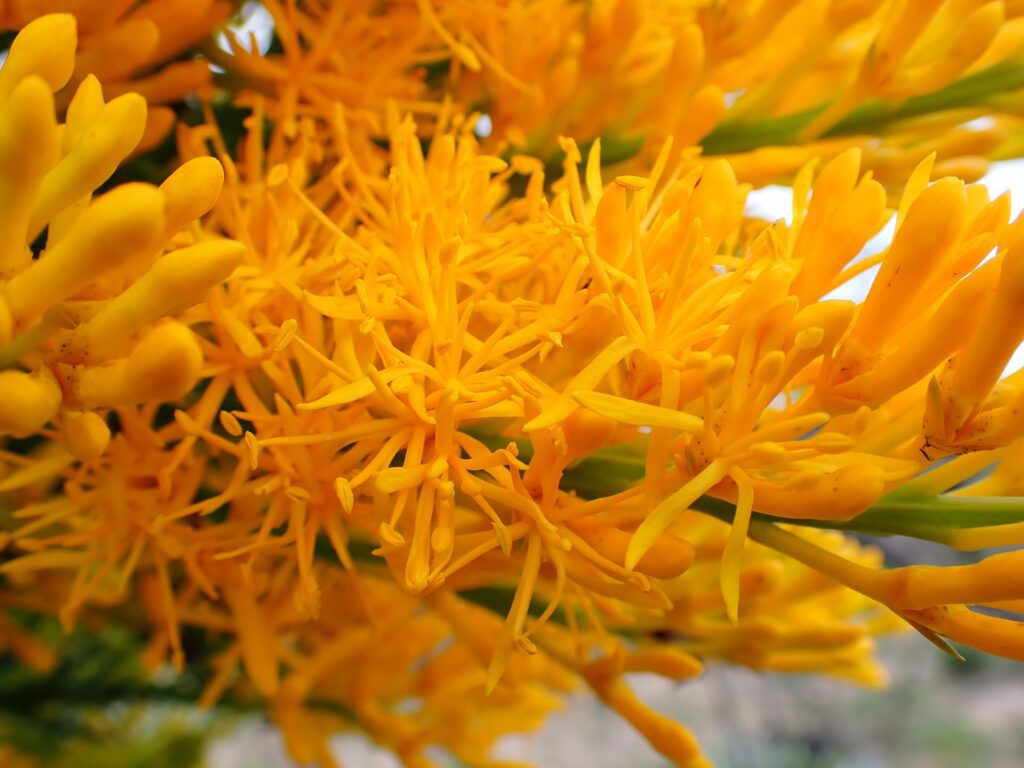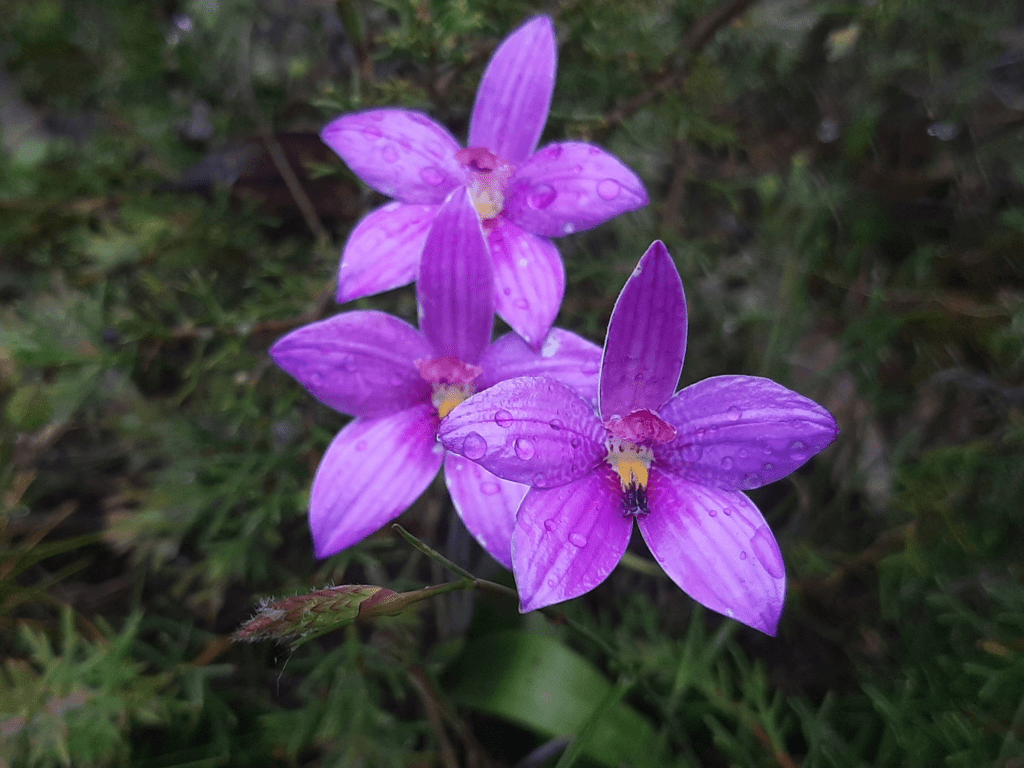12 Species of Christmas in Australia
1. Christmas Morrison
Verticordia nitens
Key features/fun facts: Their inflorescence create a beautiful crown of golden flowers adding pops of colour around the landscape as well as a subtle honey scent, attracting native bees and butterflies.
Indigenous name: Kotyeningara.
Locations: Spread throughout the Perth Metropolitan area, reaching as far North as Jurien Bay.
Do we plant them? No.
Association with Christmas: Flower Oct-Feb and often used as dried table decorations.
Photo by Lyn Alcock, Western Australia (Brand Highway heading north)

2. Western Australian Christmas Tree
Nuytsia floribunda
Key features/fun facts: The WA Christmas Tree is known as one of the worlds largest (hemi)parasitic plants. The plant is considered hemi-parasitic as it can both photosynthesise and obtain water and nutrients from it’s host plants through its haustoria ( penetrative root like structure). It has been thought to benefit from the roots of host plants over 150m away.
Indigenous name: Moodjar.
Locations: Throughout the South West Coast and Wheatbelt.
Do we plant them? No.
Association with Christmas: They can reach up to 10m tall and siplay stunning golden flowers through December, giving it it’s name.
Photos by Terry Dunham, Stirling Ranges NP, Western Australia


3. Geraldton Wax
Chamelaucium uncinatum
Key features/fun facts: Geraldton wax is a household favourite in WA as they produce pretty dainty flowers throughout spring and summer. They make great additions to residential gardens and require full sun and well-draining soil. Uncinatum means ‘hooked’ in Latin, referring to the tip of the leaves.
Locations: Widely distributed across the coast line of the south west as far north of Geraldton.
Do we plant them? No.
Association with Christmas: Often used as table arrangements and flower throughout spring and summer.
Photo by Sophie Xiang, Western Australia

4. Smokebush
Conospermum stoechadis
Key features/fun facts: Smokebush got its name because its flowers resemble drifting plumes of smoke.
Locations: Distributed widely throughout the South West.
Do we plant them? No.
Association with Christmas: Flower from July through to December.
Photos by Lyn Alcock, Narrogin, Western Australia


5. Summer-Scented Wattle
Acacia rostellifera
Key features/fun facts: Resprout after fire via their underground stems and suckers. These suckers also allow them to colonise significant areas and often forming thickets.
Locations: Distributed across almost the whole of the WA coastline.
Do we plant them? Yes.
Association with Christmas: Flowers Jul- Dec and has a beautiful summer scent for the Christmas period.

6. Candlestick Banksia
Banksia attenuata
Key features: Frost and drought tolerant, it’s great for gardens and comes in a dwarf form at nurseries also.
Locations: Found thoughout the South West
Do we plant them? Yes.
Association with Christmas: Flowers from Oct-Feb.
Photos by Terry Dunham, Great Southern Region, Western Australia.


7. Pink Enamel Orchid
Elythranthera emarginata
Key features/fun facts: Has a single hairy leaf.
Locations: Widely scattered throughout the South West.
Do we plant them? No.
Association with Christmas: Flowers from October to December.
Photo by Terry Dunham, Stirling Range NP, Western Australia

8. Pink Summer Calytrix
Calytrix fraseri
Key features: Leaves have been known to have a ‘spicy’ fragrance when crushed.
Locations: Throughout the Swan Coastal Plain and Wheatbelt.
Do we plant them? No.
Association with Christmas: Vivid pink stars can be seen scattered across the landscape. Flowers from November through to January.
Photo by Malcolm Roberts @aussiebushguide (Instagram)

9. Yellow Flame Grevillea
Grevillea eriostachya
Key features/fun facts: Dominant features are the tall leafless branches with brilliant yellow/orange inflorescence reaching 2m above. They give a small resemblance to a traditional Christmas Tree shape. Can be spotted spread widely throughout WA and NT.
Locations: Can be spotted spread widely throughout WA and NT.
Do we plant them? No
Association with Christmas: flower throughout summer and have a traditional Christmas tree shape.
Photo by Gary Thompson, Kalbarri, Western Australia

10. Gorada
Melaleuca lateriflora
Key features/fun facts: Oval shaped leaves and white/cream flowers. We plant this species on slightly saline sites as it is listed as moderately salt tolerant.
Locations: scattered throughout the South West and Wheatbelt areas.
Do we plant them? Yes.
Association with Christmas: Flowers September through to February.

11. Fringe Lily
Grevillea eriostachya
Key features/fun facts: There are roughly 40 different fringe lily species. The brilliant purple flowers only last a few hours and they require ‘buzz pollination’, meaning their pollen is released through vibration.
Locations: Can be spotted from the Kennedy Ranges down to Walpole.
Do we plant them? No.
Association with Christmas: Flowers from May through to December.
Photo by Gareth Gorman, Wireless Hilll Park, Western Australia

12. Grass Tree
Xanthorrhoea preissii
Key features/fun fact: this tree has a symbiotic friend called Mycorrhiza fungi which lives among their roots, helping the plant with water and nutrient uptake. The resin from the plant was also traditionally used by Indigenous communities for glue in spear making.
Locations: Found throughout the South West and along Swan Coastal Plain.
Do we plant them? No.
Association with Christmas: Tall white/cream inflorescence can be seen in flower throughout the months of June to December.
Photos by Malcolm Roberts @aussiebushguide (Instagram)

Did you know that you can have a nature-positive Christmas this holiday season by planting native trees with us?
It costs $4.00 to plant one tree with Carbon Positive Australia, and when you plant trees with us, you are funding a process and vision for full ecological restoration. Give a gift that keeps on giving this Christmas.
